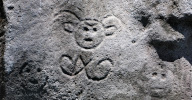| Kaz | Enfo | Ayiti | Litérati | KAPES | Kont | Fowòm | Lyannaj | Pwèm | Plan |
| Accueil | Actualité | Haïti | Bibliographie | CAPES | Contes | Forum | Liens | Poèmes | Sommaire |
Sistèm alfabè kreyòl aysyen: The Haitian Creole writing system (© Emmanuel W. VEDRINE) |
Pati I: Part I -- Vwayèl oral: Oral vowels (I); Senbòl AFE (Alfabè Fonetik Entènasyonal): IPA (International Phonetic Alphabet) Symbol (II); Egzanp an kreyòl: Example in Haitian Creole (III). |
|
Part II: Pati II --Tradiksyon mo [nan egzanp III] ak fraz ilistrasyon: Translation of words [from example III] and phrases to illustrate them. |
(I) (II) (III) VWAYÈL ORAL: ORAL VOWELS VWAYÈL NASAL: NASAL VOWELS DEMI VWAYÈL: SEMI VOWELS KONSÒN: CONSONANTS (1) mache: to walk. (3) èni: hernia. (4) machin: car. (5) taso: dry meat (seasoned and grilled). (6) bone: to mark out (field, land). (8) van: wind. (9) ven: twenty. (11) zuit: oyster. (13) dyak: a) deacon. b) jack (automobile). (14) kaba: a) to finish, to finish off, to put and end to. b) adj. sold out. (16) tande: a) to hear. b) to listen to. (18) degi (djegi, dyegi, gyegi): bonus, extra measure, little extra, supplement (for good measure). (19) ajite: to shake to shake up. (20) rakèt: a) racket (tennis, etc). b) prickly pear (large cactus), nopal. (21) jalon: surveyor’s pole. (22) klima: climate. (23) kadnase: to padlock. (24) mang (lanmè): mangrove. (25) apeti: appetite. (26) penetre: to penetrate. (27) danse: to dance. (28) wete: to take out, to remove. (29) nève: nervous (30) ze: egg. |
|
(1) ale: to go. Li lè pou n ale: It’s time to go. (2) ede: to help. M ap vin ede ou: I am coming to help you. (3) pèdi: to lose. Pa pèdi espwa: Don’t lose hope. (4) itilize: to use. Itilize sa a pito: Use this one instead. Machin nan anpàn: The car breaks down. (5) ogmante: to increase. Yo ogmante pri a: They have increased the price. (6) òlòj: clock. Li (fè) twazè nan òlòj nan salon on: It’s three o’clock by or according to the livingroom clock. (7) ouvri: to open. Ou ka ouvri pòt la pou mwen silvouplè?: Can you open the door for me please? (8) antre: to enter, get in. Antre la a: Enter here. (9) enterè: interest. M pa gen oken enterè fè sa: I have no interest in doing that. (10) ons: ounce. Mete 2 ons ji nan bibon an pou tibebe a: Put two ounces of juice in the bottle for the baby. La a glise, atansyon pou pa tonbe: It’s slippery care, be careful not to fall. (11) uit: eight. Ou ka pot(e) uit pòm ban mwen silvouplè?: Can you bring me eight apples please?. Ou gen dizuit ane kounyeya, ou granmoun: You are eighteen now, you are an adult. (12) wouze: to water. Lanmou se yon flè ki dwe wouze souvan: Love is a flower that should be watered often. (13) yenyen: to mimic. Lè msye ap pale, li yenyen: He mimics when he is talking. (14) bote: beauty. Li gen yon bote estraòdinè: She’s extremely beautiful.(15) chèche: to look for. Sa w ap chèchela la a?: What are you looking for here?.Kibò ou achte li?: Where did you buy it?.(16) doute: to doubt. Mwen doute Jan ap vin demen: I doubt Jean is coming tomorrow. (17) fouye: to dig. Chen an ap fouye yon zo: The dog is digging a bone. (18) gade: to look. Joslin ap gade nan miwa a: Joslin is looking at herself in the mirror. (19) jape: to bark. Chen sa a renmen jape: This dog likes barking. (20) kilbite: to stumble: Nou kilbite men nou pa tonbe: We stumbled but we did not fall.(21) lave: to wash. Toujou lave men ou avan ou manje: Always wash your hands before eating. (22) mentni: to maintain. Li bon pou mentni kò ou an sante: It’s good to maintain yourself in good health. (23) netwaye: to clean. Toujou netwaye kay ou: Always clean your house. (24) ling: line. Pa pile ling nan: Don’t step on the line. (25) pale: to speak, to talk. Tibebe a ap dòmi, pa pale twò fò: The baby is sleeping, don’t talk too loud. (26) rele: to call. Ou mèt itilize pòtab mwen an pou rele zanmi: You may use my cell phone to call friends. (27) sale: (to be) salty. Lanmè pa vante di l sale: The sea doesn’t brag that it’s salty. (28) tanmen: to begin. Ki lè ou tanmen travay?: What time do you start working?. (29) vale: to swallow. Pwason an vale zen an: The fish swallows the hook. (30) egzòtasyon: exhortation. Li tande egzòtasyon papa l: He hears his dad’s exhortation. |
References
- VALDMAN, Albert et al. 2007. Haitian Creole-English Bilingual Dictionary. The Indiana University: Bloomington, IN.
- VEDRINE, Emmanuel W. 2003. An annotated bibliography On Haitian Creole: A review of publications from colonial times to 2000. Educa Vision: Coconut Creek, FL.
- VEDRINE, Emmanuel W. 1996. Gramè Kreyòl Védrine (Védrine's Grammar of Haitian Creole). VEDCREP : Boston, MA.
- VEDRINE, Emmanuel W. 1995.Petit lexique du créole haïtien. Orèsjozèf Publications: Randolph, MA.
- VEDRINE, Emmanuel W. 1992. Dictionary of Haitian Creole Verbs with phrases and idioms. Soup to Nuts: Cambridge, MA.
- VEDRINE, Emmanuel W. (Unpub.). “Kreyol Without Toil: an introductory course to Haitian Creole”.
![]()
